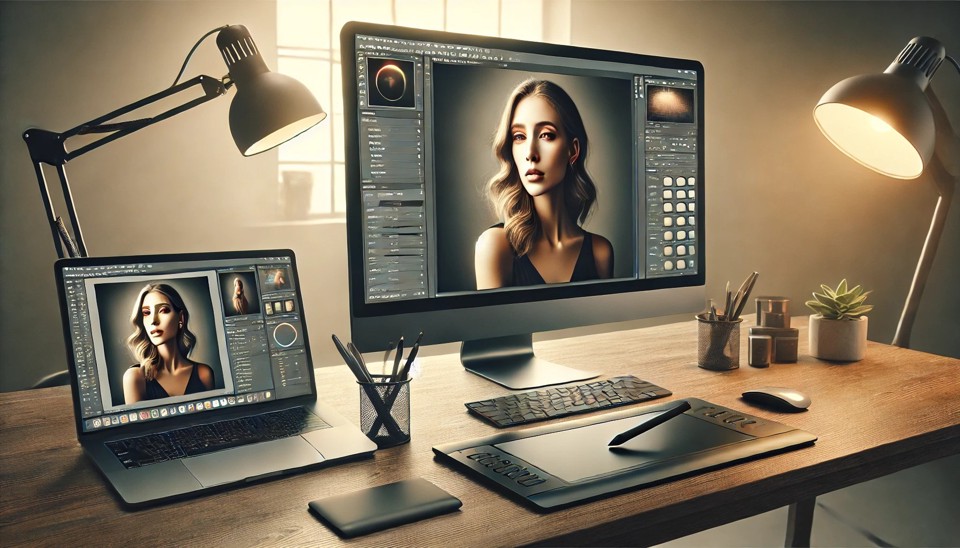
Photo retouching is an essential skill for photographers and graphic designers who aim to produce polished, professional images. Mastering advanced retouching techniques can elevate your work, making it stand out in a competitive industry. In this blog, we explore techniques every professional should learn to achieve stunning results.
Skin Retouching: Enhancing Natural Beauty
Achieving Flawless Skin with Frequency Separation
Frequency separation is a powerful technique that allows you to edit skin texture and tone separately. This method involves splitting the image into two layers: one for the fine details (like skin texture) and another for broader tones and colors. By using tools like the Healing Brush or Clone Stamp on the texture layer and soft adjustments on the tone layer, you can correct imperfections without losing natural detail.
Retaining Realism with Dodge and Burn
Over-smoothing skin can lead to unnatural results. Dodge and burn is a subtle method to enhance skin while preserving its texture. Use a soft brush with low opacity to brighten highlights (dodge) and deepen shadows (burn), bringing out natural contours and minimizing blemishes in a realistic way.

Mastering Color Grading: Setting the Mood
Creating Mood with Selective Color Adjustments
Color grading can drastically change the mood of a photo. By using adjustment layers like Curves, Color Balance, and Hue/Saturation, you can introduce warm or cool tones to evoke specific emotions. For instance, teal and orange tones work well for cinematic effects, while pastel hues suit dreamy aesthetics.
Leveraging LUTs for Consistency
Look-Up Tables (LUTs) are a great way to maintain consistent color grading across multiple photos. Import pre-made LUTs into your editing software or create custom ones to match your style. This ensures all images in a series have a cohesive look, which is especially important for branding or portfolio work.
Refining Eyes and Features: The Window to the Soul
Sharpening and Enhancing Eye Details
The eyes are the focal point of most portraits. Use sharpening techniques and the Dodge tool to make the eyes pop. Add catchlights to give them a spark of life, but avoid overdoing it, as this can make them look unnatural.
Balancing Feature Adjustments with Liquify
The Liquify tool is perfect for subtle feature enhancements, such as refining jawlines or adjusting smiles. Use the Forward Warp tool with low pressure to maintain realistic proportions. Remember, subtlety is key—overuse can lead to distorted, unrealistic results.
Perfecting Hair: Volume and Shine
Cleaning Flyaways with Precision
Stray hairs can distract from an otherwise polished image. Use the Clone Stamp tool or Healing Brush to remove flyaways while maintaining the natural flow of the hair. For complex areas, such as around the edges, zoom in and work carefully to preserve realism.
Adding Shine and Depth
Hair can look flat in photos without proper jewelry retouching service. Use the Dodge tool to add highlights and the Burn tool to deepen shadows, creating a sense of depth and shine. Combine these adjustments with a slight sharpening effect to make hair strands stand out.
Background Enhancement: Elevating the Scene
Removing Distractions with Content-Aware Fill
Unwanted elements in the background can detract from your subject. The Content-Aware Fill tool in Photoshop is excellent for seamlessly removing these distractions. Select the area to be removed, and Photoshop will intelligently fill it in with matching details from the surrounding area.
Adding Blur for Depth
A shallow depth of field can draw attention to your subject by blurring the background. If this effect wasn’t achieved in-camera, you can replicate it in post-processing using tools like Gaussian Blur. Mask the subject carefully to ensure the effect looks natural.

Precision Masking: Targeted Adjustments
Refining Selections with Advanced Tools
Creating precise selections is critical for targeted adjustments. Use tools like Select Subject, Refine Edge, and the Pen Tool to isolate areas with accuracy. Combine these selections with layer masks to make non-destructive edits, ensuring flexibility for future adjustments.
Applying Local Adjustments
Once you’ve masked the desired area, you can make localized changes, such as increasing brightness, adjusting contrast, or applying color corrections. This technique is ideal for emphasizing key elements without affecting the entire image.
Enhancing Textures: Adding Depth and Dimension
Utilizing High-Pass Sharpening
High-pass sharpening is an advanced technique for enhancing textures without overdoing it. Duplicate your image layer, apply a High Pass filter, and set the blend mode to Overlay or Soft Light. Adjust the opacity to control the effect for subtle yet impactful sharpening image retouching services.
Creating Texture Overlays
Adding textures can give your photos a unique, artistic touch. Overlay materials like paper, fabric, or grunge textures onto your image, and experiment with blend modes. This technique is particularly effective for creating vintage or fine-art looks.
Advanced Composite Techniques: Blending Images Seamlessly
Matching Lighting and Perspective
When combining elements from different images, matching lighting and perspective is crucial for realism. Analyze the direction of light and shadows in each image and adjust using Levels or Curves. Use the Transform tool to align perspectives correctly.
Seamless Blending with Layer Masks
Layer masks are invaluable for compositing. Use a soft brush with varying opacity to blend elements smoothly. This method ensures seamless transitions and allows for non-destructive edits if adjustments are needed later.
Polishing the Final Image: The Finishing Touches
Color Correction for Cohesion
After making individual adjustments, review the overall color balance. Use tools like Color Balance, Curves, or even third-party plugins to ensure all elements of the image work harmoniously together.
Exporting for Different Mediums
Preparing your image for different platforms is the final step. Save your work in high resolution for print and optimize for web by reducing file size without compromising quality. Tools like Adobe Photoshop’s Save for Web feature can help maintain sharpness and clarity.
Conclusion
Advanced photo retouching techniques require patience, practice, and an eye for detail. By mastering these methods, you can transform ordinary images into extraordinary works of art. Whether you’re working on portraits, landscapes, or composites, these skills will help you achieve professional-grade results and elevate your creative projects. Start experimenting today to unlock the full potential of your photo editing prowess.
Retouching Cloudさんをフォローして最新の投稿をチェックしよう!
0 件のコメント
この投稿にコメントしよう!
この投稿にはまだコメントがありません。
ぜひあなたの声を聞かせてください。
